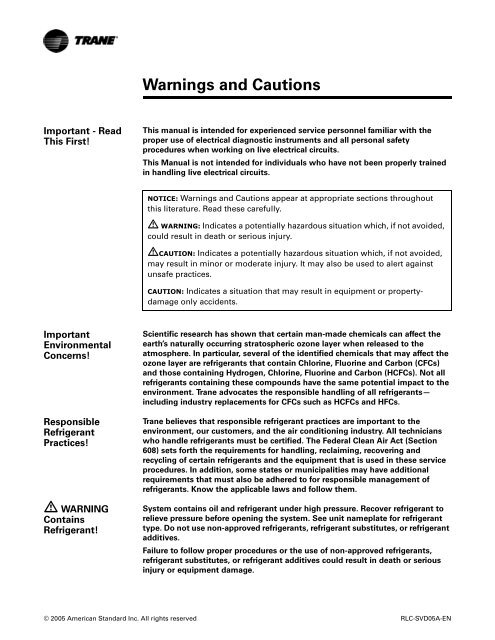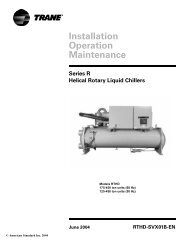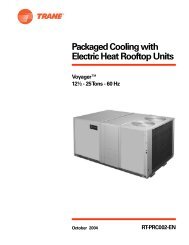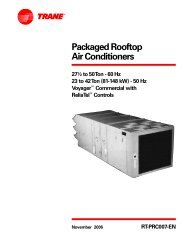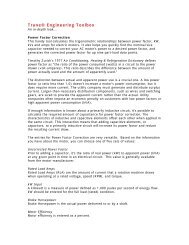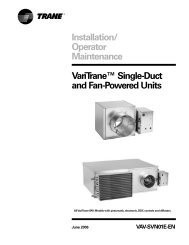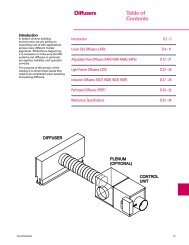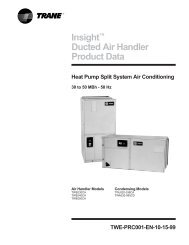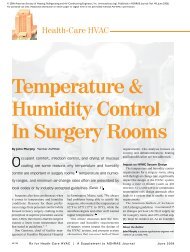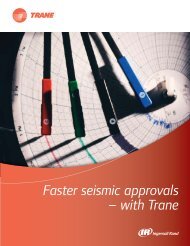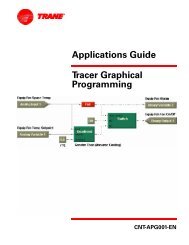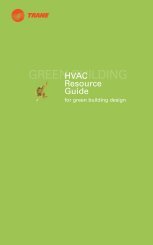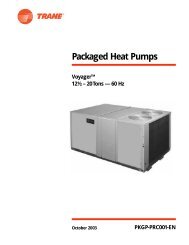RTHD and RTAC - Trane
RTHD and RTAC - Trane
RTHD and RTAC - Trane
You also want an ePaper? Increase the reach of your titles
YUMPU automatically turns print PDFs into web optimized ePapers that Google loves.
Important - Read<br />
This First!<br />
Important<br />
Environmental<br />
Concerns!<br />
Responsible<br />
Refrigerant<br />
Practices!<br />
� WARNING<br />
Contains<br />
Refrigerant!<br />
Warnings <strong>and</strong> Cautions<br />
This manual is intended for experienced service personnel familiar with the<br />
proper use of electrical diagnostic instruments <strong>and</strong> all personal safety<br />
procedures when working on live electrical circuits.<br />
This Manual is not intended for individuals who have not been properly trained<br />
in h<strong>and</strong>ling live electrical circuits.<br />
NOTICE: Warnings <strong>and</strong> Cautions appear at appropriate sections throughout<br />
this literature. Read these carefully.<br />
� WARNING: Indicates a potentially hazardous situation which, if not avoided,<br />
could result in death or serious injury.<br />
�CAUTION: Indicates a potentially hazardous situation which, if not avoided,<br />
may result in minor or moderate injury. It may also be used to alert against<br />
unsafe practices.<br />
CAUTION: Indicates a situation that may result in equipment or propertydamage<br />
only accidents.<br />
Scientific research has shown that certain man-made chemicals can affect the<br />
earth’s naturally occurring stratospheric ozone layer when released to the<br />
atmosphere. In particular, several of the identified chemicals that may affect the<br />
ozone layer are refrigerants that contain Chlorine, Fluorine <strong>and</strong> Carbon (CFCs)<br />
<strong>and</strong> those containing Hydrogen, Chlorine, Fluorine <strong>and</strong> Carbon (HCFCs). Not all<br />
refrigerants containing these compounds have the same potential impact to the<br />
environment. <strong>Trane</strong> advocates the responsible h<strong>and</strong>ling of all refrigerants—<br />
including industry replacements for CFCs such as HCFCs <strong>and</strong> HFCs.<br />
<strong>Trane</strong> believes that responsible refrigerant practices are important to the<br />
environment, our customers, <strong>and</strong> the air conditioning industry. All technicians<br />
who h<strong>and</strong>le refrigerants must be certified. The Federal Clean Air Act (Section<br />
608) sets forth the requirements for h<strong>and</strong>ling, reclaiming, recovering <strong>and</strong><br />
recycling of certain refrigerants <strong>and</strong> the equipment that is used in these service<br />
procedures. In addition, some states or municipalities may have additional<br />
requirements that must also be adhered to for responsible management of<br />
refrigerants. Know the applicable laws <strong>and</strong> follow them.<br />
System contains oil <strong>and</strong> refrigerant under high pressure. Recover refrigerant to<br />
relieve pressure before opening the system. See unit nameplate for refrigerant<br />
type. Do not use non-approved refrigerants, refrigerant substitutes, or refrigerant<br />
additives.<br />
Failure to follow proper procedures or the use of non-approved refrigerants,<br />
refrigerant substitutes, or refrigerant additives could result in death or serious<br />
injury or equipment damage.<br />
© 2005 American St<strong>and</strong>ard Inc. All rights reserved RLC-SVD05A-EN


